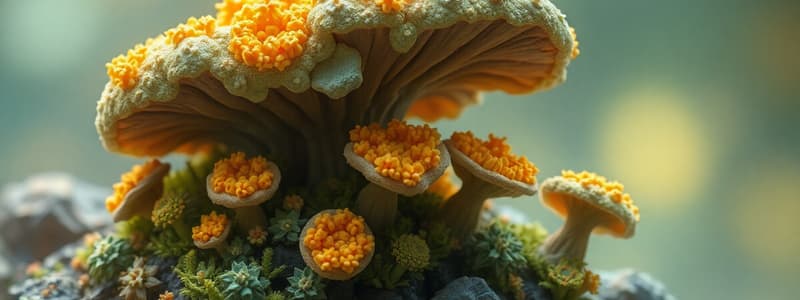Podcast
Questions and Answers
What is the primary role of the fungal component in a lichen?
What is the primary role of the fungal component in a lichen?
- Provides carbon compounds for the photosynthetic partner
- Provides nitrogen for the photosynthetic partner
- Provides protection and a suitable environment for growth (correct)
- Provides a source of energy for the photosynthetic partner
Which of these is NOT a type of lichen?
Which of these is NOT a type of lichen?
- Appendiculate (correct)
- Crustose
- Fruticose
- Foliose
Which of the following is NOT a characteristic of endophytic fungi?
Which of the following is NOT a characteristic of endophytic fungi?
- They live in the intercellular spaces of plants
- They can improve their host's resistance to herbivores
- They are found in a variety of plant species
- They are always harmful to their host (correct)
What is the primary mode of asexual reproduction in lichens?
What is the primary mode of asexual reproduction in lichens?
Which of the following statements about the relationship between a fungus and a photosynthetic partner in a lichen is true?
Which of the following statements about the relationship between a fungus and a photosynthetic partner in a lichen is true?
Which of these organisms are NOT protists?
Which of these organisms are NOT protists?
What is the defining characteristic of plasmodial slime molds?
What is the defining characteristic of plasmodial slime molds?
How do cellular slime molds obtain their food?
How do cellular slime molds obtain their food?
What is the function of hypermastigotes in termites?
What is the function of hypermastigotes in termites?
What is the name of the amoeboid stage that cellular slime molds form when they aggregate?
What is the name of the amoeboid stage that cellular slime molds form when they aggregate?
What is the primary reproductive method for glomeromycetes?
What is the primary reproductive method for glomeromycetes?
Which of the following is NOT a characteristic of basidiomycetes?
Which of the following is NOT a characteristic of basidiomycetes?
What type of symbiotic relationship do leaf-cutter ants have with the fungi they cultivate?
What type of symbiotic relationship do leaf-cutter ants have with the fungi they cultivate?
What is the role of Streptomyces bacteria in the symbiotic relationship between leaf-cutter ants and their fungal gardens?
What is the role of Streptomyces bacteria in the symbiotic relationship between leaf-cutter ants and their fungal gardens?
How do glomeromycetes benefit from their association with plants?
How do glomeromycetes benefit from their association with plants?
Which of the following is an example of a basidiocarp?
Which of the following is an example of a basidiocarp?
What is the significance of the basidium in the life cycle of basidiomycetes?
What is the significance of the basidium in the life cycle of basidiomycetes?
What is the ecological role of fungi as decomposers?
What is the ecological role of fungi as decomposers?
Which fungal phylum is characterized by the formation of arbuscular mycorrhizae with plants?
Which fungal phylum is characterized by the formation of arbuscular mycorrhizae with plants?
Which of the following is NOT a fungal phylum?
Which of the following is NOT a fungal phylum?
Which fungal phylum produces sexual spores internally in sacs called asci?
Which fungal phylum produces sexual spores internally in sacs called asci?
What is the general term for a fungal infection in animals?
What is the general term for a fungal infection in animals?
Which of the following is NOT a characteristic of fungi?
Which of the following is NOT a characteristic of fungi?
Which of the following is a type of mycotoxin produced by Aspergillus flavus?
Which of the following is a type of mycotoxin produced by Aspergillus flavus?
Which of the following organisms is NOT included in the supergroup Unikonta?
Which of the following organisms is NOT included in the supergroup Unikonta?
Which of the following is a characteristic of slime molds?
Which of the following is a characteristic of slime molds?
Flashcards
Lichen
Lichen
A symbiotic association between a fungus and a photosynthetic microorganism.
Endophytic fungi
Endophytic fungi
Fungi that live inside the intercellular spaces of plants.
Bioindicators
Bioindicators
Organisms used to assess environmental health, like lichens indicating air quality.
Asexual reproduction in lichens
Asexual reproduction in lichens
Signup and view all the flashcards
Ascomycetes vs Basidiomycetes
Ascomycetes vs Basidiomycetes
Signup and view all the flashcards
Glomeromycetes
Glomeromycetes
Signup and view all the flashcards
Basidiomycetes
Basidiomycetes
Signup and view all the flashcards
Basidiospores
Basidiospores
Signup and view all the flashcards
Arbuscular mycorrhizae
Arbuscular mycorrhizae
Signup and view all the flashcards
Fungi as decomposers
Fungi as decomposers
Signup and view all the flashcards
Endophytes
Endophytes
Signup and view all the flashcards
Leaf-cutter ants and fungi
Leaf-cutter ants and fungi
Signup and view all the flashcards
Club fungi
Club fungi
Signup and view all the flashcards
Zygomycota
Zygomycota
Signup and view all the flashcards
Glomeromycota
Glomeromycota
Signup and view all the flashcards
Basidiomycota
Basidiomycota
Signup and view all the flashcards
Ascomycota
Ascomycota
Signup and view all the flashcards
Mycosis
Mycosis
Signup and view all the flashcards
Fusarium
Fusarium
Signup and view all the flashcards
Unikonta
Unikonta
Signup and view all the flashcards
Amoebozoans
Amoebozoans
Signup and view all the flashcards
Plasmodium in slime molds
Plasmodium in slime molds
Signup and view all the flashcards
Cellular slime molds
Cellular slime molds
Signup and view all the flashcards
Gymnamoebas
Gymnamoebas
Signup and view all the flashcards
Entamoeba histolytica
Entamoeba histolytica
Signup and view all the flashcards
Photosynthetic protists
Photosynthetic protists
Signup and view all the flashcards




